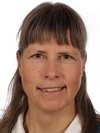The geomagnetic field shields our habitat against solar wind and radiation from space. Due to the geometry of the field, the shielding in general is weakest at high latitudes. It is also anomalously weak in a region around the south Atlantic known as South Atlantic Anomaly (SAA), and the global dipole moment has been decreasing by nearly 10 percent since direct measurements of field intensity became possible in 1832. Due to our limited understanding of the geodynamo processes in Earth’s core, it is impossible to reliably predict the future evolution of both dipole moment and SAA over the coming decades. However, lack of magnetic field shielding as would be a consequence of further weakening of dipole moment and SAA region field intensity would cause increasing problems for modern technology, in particular satellites, which are vulnerable to radiation damage. A better understanding of the underlying processes is required to estimate the future development of magnetic field characteristics. The study of the past evolution of such characteristics based on historical, archeo- and paleomagnetic data, on time-scales of centuries to millennia, is essential to detect any recurrences and periodicities and provide new insights in dynamo processes in comparison to or in combination with numerical dynamo simulations. We propose to develop two new global spherical harmonic geomagnetic field models, spanning 1 and 10 kyrs, respectively, and designed in particular to study how long the uninterrupted decay of the dipole moment has been going on prior to 1832, and if the SAA is a recurring structure of the field.
We combine for the first time all available historical and archeomagnetic data, both directions and intensities, in a spherical harmonic model spanning the past 1000 years. Existing modelling methods are adapted accordingly, and the GEOMAGIA.v3 database geomagia.gfz-potsdam.de/index.php is complemented with newly published data. In close collaboration with the paleomagnetic laboratory of GFZ we further acquire some new archeomagnetic data from the Cape Verde islands from historical times to better constrain the early evolution of the present-day SAA. In order to study the long-term field evolution and possible recurrences of similar weak field structures in this region, we produce new paleomagnetic records from available marine sediment cores off the coasts of West Africa, Brazil and Chile. This region is weakly constrained in previous millennial scale models. Apart from our main aim to gain better insights into the previous evolution of dipole moment and SAA, the models are used to study relations between dipole and non-dipole field contributions, hemispheric symmetries and large-scale flux patterns at the core-mantle boundary. These observational findings provide new insights into geodynamo processes when compared with numerical dynamo simulation results. Moreover, the models can be used to estimate past geomagnetic shielding above Earth’s surface against solar wind and for nuclide production from galactic cosmic rays.
Time Frame
- 2013 - 2016
Funding
- DFG, SPP 1488 “Planetary Magnetism”
Principal Investigators
- Monika Korte (GFZ Potsdam)
- Norbert Nowaczyk (GFZ Potsdam)
Personnel
- Robin Senftleben (GFZ Potsdam)
- Ute Frank (GFZ Potsdam)
Partners
- Christopher Finlay, DTU Space, Denmark
- Maxwell Brown, (GFZ Potsdam and now at University of Iceland)
Project Website
Research Unit
- RU1 (Globale Prozesse)
Publications
- Korte, M., M. Brown, U. Frank, R. Senftleben and N. Nowaczyk (2017): Global geomagnetic field reconstructions from centuries to excursions. In Magnetic Fields in the Solar System, edited by H. Lühr, J. Wicht, S. Gilder, M. Holschneider, Astrophysics and Space Science Library 448, DOI 10.1007/978-3-319-64292-5_3, Springer
- Frank, U., Nowaczyk, N., Frederichs, T., Korte, M. (2017): Paleo- and rock magnetic investigations on Late Quaternary sediments from low latitudes I: Geomagnetic paleosecular variation and relative paleointensity records from the Tobago Basin, Southeast Caribbean. - Geophysical Journal International, 208, 3, p. 1740-1755.
- Constable, C., Korte, M., Panovska, S. (2016): Persistent high paleosecular variation activity in southern hemisphere for at least 10 000 years. - Earth and Planetary Science Letters, 453, p. 78-86.
- Brown, M., Donadini, F., Nilsson, A., Panovska, S., Frank, U., Korhonen, K., Schuberth, M., Korte, M., Constable, C. G. (2015): GEOMAGIA50.v3: 2. A new paleomagnetic database for lake and marine sediments. - Earth Planets and Space, 67, 1.
- Brown, M., Donadini, F., Korte, M., Nilsson, A., Korhonen, K., Lodge, A., Lengyel, S. N., Constable, C. G. (2015):GEOMAGIA50.v3: 1. general structure and modifications to the archeological and volcanic database. - Earth Planets and Space, 67.
- Constable, C., Korte, M. (2015): Centennial- to Millennial-Scale Geomagnetic Field Variations. - In: Schubert, G. (), Treatise on Geophysics, Oxford : Elsevier, p. 309-341.
- Korte, M., Senftleben, R., Brown, M., Finlay, C., Feinberg, J., Biggin, A. (2016): Combining archeomagnetc and volcanic data with historical geomagnetic reconstructions to reconstruct global field evolution over the past 1000 years, including new paleomagnetic data from historical lava flows on Fogo, Cape Verde - Abstracts, AGU 2016 Fall Meeting (San Francisco, USA 2016).
- Senftleben, R., Korte, M., Finlay, C. (2016): Global magnetic field modelling with archeomagnetic and historical data, (Geophysical Research Abstracts, Vol. 18, EGU2016-13059, 2016), General Assembly European Geosciences Union (Vienna, Austria 2016).
- Korte, M., Frank, U., Nowaczyk, N., Frederichs, T., Brown, M. (2015): Holocene Southern Atlantic Earth's magnetic field variations - Abstracts, Joint Assembly AGU-GAC-MAC-CGU (Montreal, Canada 2015).
- Korte, M., Frank, U., Nowaczyk, N., Frederichs, T., Brown, M. (2015): Holocene southern Atlantic Earth's magnetic field variations - Scientific Programme, 26th IUGG General Assembly (Prague 2015).




